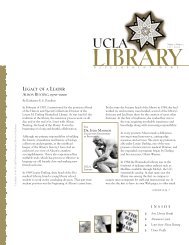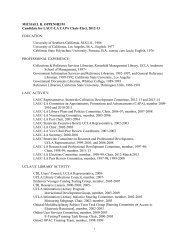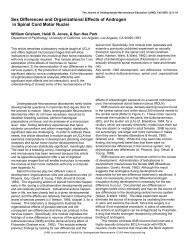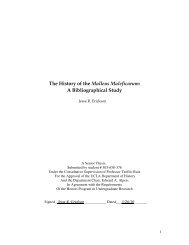Research Paper - UCLA Library
Research Paper - UCLA Library
Research Paper - UCLA Library
You also want an ePaper? Increase the reach of your titles
YUMPU automatically turns print PDFs into web optimized ePapers that Google loves.
image of almost cosmic power. In a span of forty years an individual [had] been transposed into<br />
a symbol” (Strong, Gloriana 9).<br />
However, such a positive representation of Elizabeth I is not the result of objective study<br />
of the Elizabethan Age. The Elizabethan mythos also carries with it the political implications of<br />
Elizabethan propaganda machine as the images of the queen that were perpetuated throughout<br />
her reign were carefully sculpted to provide the unmarried queen with an aura of authority and<br />
right to rule. Such positive imaginations of Elizabeth I unfortunately obscure discussion of any<br />
negative presentations of a queen presiding over a generally misogynistic society without a<br />
biological heir.<br />
This thesis will employ a more narrow definition of the Elizabethan mythos, focusing<br />
Gu 5<br />
only on the early constructions of the Elizabethan image up until 1613, the end of the first decade<br />
after her death. Therefore, the Elizabethan mythos will refer more to what was known, written,<br />
or praised about Elizabeth from the beginning of her reign to 1613. In addition, while Elizabeth’s<br />
reputation was clearly influenced by the sonnet vogue of the 1590s and Spenser’s Faerie Queene<br />
among other poetic praises of the queen, this paper focuses more on the way in which the<br />
Elizabethan mythos manifested itself in drama and performance, particularly in The Revenger’s<br />
Tragedy (1606) and Henry VIII (1613). Henry VIII, which dramatizes the Tudor king’s divorce<br />
from both Katherine of Aragon and the Catholic Church, concludes with the celebration of the<br />
baby Elizabeth’s birth. However, the Archbishop of Canterbury’s prophecies about the queen’s<br />
future accomplishments are overshadowed by predictions about the glories of her successor’s<br />
reign, shifting the significance of Elizabeth’s reign. The Revenger’s Tragedy paints a more<br />
obvious, yet problematic picture of contemporary attitudes towards Elizabeth’s legacy.<br />
Gloriana’s skull, an object which reinforces and spurs on Vindice’s thirst for revenge, provides a











